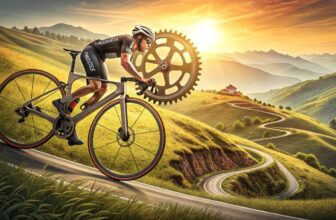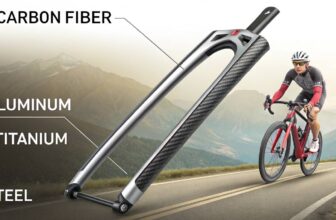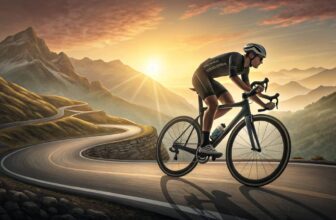Imagine the wind whipping past as you surge forward, every pedal stroke bringing you closer to victory.
Road cycling races are not just speed and endurance tests—they’re strategic battles where every decision counts. Whether you’re a seasoned pro or an enthusiastic amateur, mastering race strategies can transform your performance from good to legendary.
At MyBikeReview.com, we delve deep into the art and science of road cycling, uncovering the secrets that separate the champions from the pack. Ready to navigate the road to triumph?
Let’s gear up and pedal into the world of masterful road cycling race strategies that will elevate your game and keep you ahead of the competition.
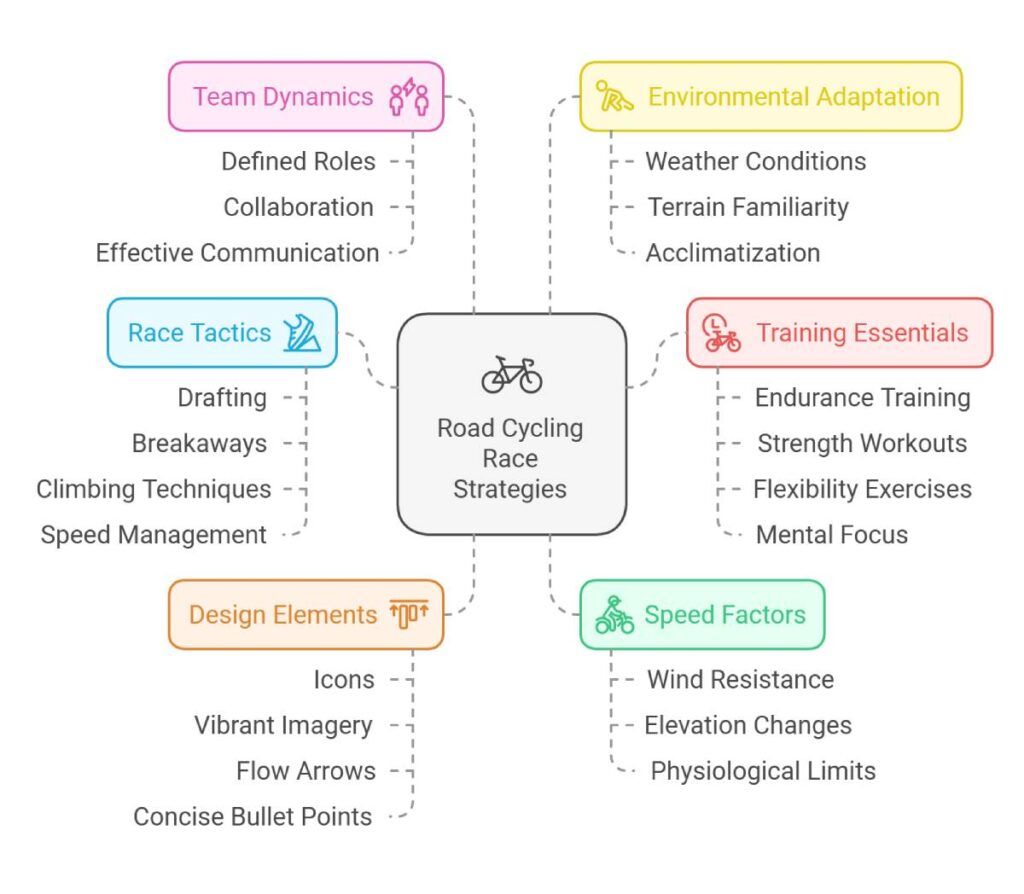
Road Cycling Race Strategy Basics
For the brave souls diving into road cycling races, getting a grip on the essential spiel might just be your golden ticket to the finish line. Here, we spill the beans on what nudges that speedo needle and the superpowers of teamwork.
Understanding Cycling Speed Factors
When it comes to zipping through a race, many different quirks come into play. Getting a feel for these quirks helps cyclists pedal faster and harder.
- Wind Conditions: The wind’s a crafty one. Got a headwind? It’s gonna feel like you’re riding through molasses. Catch a tailwind, though, and you’re flying! Crosswinds? That’s a balancing act, folks. They can mess with your bike, so keep your wits about you. For tips on riding the wind, peek at our cycling drafting technique.
- Elevation and Atmosphere: Climbing up? Air thins, so you huff and puff more — not fun for your speed. Racing down? Get ready for a rush, but hold onto those brakes, alright? Also, think about the weather: cooler air can keep you going longer, but if it’s too toasty, you might just melt away. Check out our road cycling position page for some aerodynamic wisdom.
- Physiological Factors: The human body is a machine. With top-notch power, a steady heart, and spot-on efficiency, you’ll fly past that competition. Training’s your best pal here. Scope out our road cycling training plan for guidance on gearing up.
| Environmental Factor | Impact on Speed |
|---|---|
| Headwind | Slows Ya Down |
| Tailwind | Boost Ya Up |
| Crosswind | It’s Tricky |
| High Elevation | Winded |
| Low Elevation | Smooth Sailing |
| Hot Temperature | Drains Ya |
| Cool Temperature | Keeps Ya Going |
Importance of Team Dynamics
In big-league cycling, it’s not just about pedaling hard — it’s about pedaling smart with your crew. Each player on the team has a task, making sure their leader is the star of the show.
- Roles in a Team: You’re looking at a squad of eight — one standing tall as a leader, maybe a second in the wings, and the rest, the domestics, hustling to keep them on top. They set the pace, block the wind, and jump in with wrenches if needed. Wanna see how it all plays out? Check road cycling team dynamics.
- Value of Collaboration: It’s a group sport, and the team’s hustle can turn the tide. Breakaways, slipstreams, you name it — they’re all about boosting the leader’s odds. At the end of the day, it’s teamwork that often clinches the trophy.
- Communication and Strategy: Talk is power. Teams stay hooked with radios, swapping plans, tweaking tactics, and reacting to every twist and turn. Crystal-clear chatter can be the difference between snatching victory or chalking up defeat.
For more on syncing up your squad and nailing those race plans, dive into our group ride etiquette article.
By getting your head around these basics, cyclists can gear up for the races and rev up their game.
Teamwork in Road Cycling
Teamwork ain’t just a buzzword; it’s the secret sauce to smashing it in road cycling races. Each rider has a job to do, and when they click like a well-oiled machine, victory’s just around the corner. Team dynamics are what keeps the wheels turning, and every cyclist needs to know their gig and work together like the ultimate squad.
Roles in a Grand Tour Team
A grand tour team usually rolls in with 8 riders. Each one’s got a job that mixes together to whip up some big-picture success. Here’s the lowdown:
- Leader: Call ’em captain, call ’em hopeful champion, but they’re the one the team’s banking on for wins. The spotlight’s on them.
- Domestiques: These champs have the leader’s back, doing anything from fetching water to blocking rival attacks. They’re the unsung heroes.
- Sprinters: Their jam? High-speed finishes. Keep them wrapped up tight during flat stages, and they’ll bring home stage wins.
- Climbers: Love ’em some hilltop heroics. They pace up mountains, ensuring the leader doesn’t get left in the dust.
- Time Trialists: Masters of solo speed contests, they shine in the time trials, and they’re invaluable in team events too.
- All-Rounders: Jack-of-all-terrain types. They jump in wherever needed to support the gang.
- Protected Rider: Your mysterious contender who might just pull a rabbit out of the hat if the leader hits a snag.
- Rouleurs: Got the stamina for long hauls and keeping spirits high all through the race.
Value of Team Collaboration
Team collaboration is the rock ‘n roll of road racing strategies. Here’s why it’s pure gold:
- Protecting the Leader: Members form a human shield against winds and sneaky opponents, setting up the leader for those fantastic finishes (Sports Medicine – Open).
- Tactical Planning: Teams huddle up to figure out when to fire up the pace, launch an attack, or play defense—all to pimp the leader’s skills and downplay the weak spots.
- Creating Opportunities: Heroic domestiques put their ambitions on the backburner so their leader can steal the spotlight, just like Mark Cavendish rocking the Tour De France (LinkedIn).
| Role | Key Function |
|---|---|
| Leader | The go-to gal/guy for stage wins and nailing the race |
| Domestiques | The guardians, tactical aides, and heavyweight lifters |
| Sprinters | Masters of the flat-out, death-or-glory finish |
| Climbers | Conquerors of peaks and supports on the tough terrains |
| Time Trialists | Lone rangers of speed, essential in time-bound contests |
| All-Rounders | Versatile wonders who adapt to whatever the race throws |
| Protected Rider | The secret ace who might just steal the show |
| Rouleurs | The marathoners, rocking the long stretches with steady pace |
Grasping these roles and the joy of team spirit puts an unbeatable edge in road cycling. Want more inside tips? Check out our write-ups on group ride etiquette and the sneaky art of cycling drafting technique.
Effects of Environmental Conditions
Environmental conditions really mess with road cycling strategies. Crack the code on how they affect performance, and cyclists can kiss those unexpected surprises goodbye.
Impact of Hot Conditions on Performance
Riding in the heat isn’t just a sweaty affair—it’s a tough slog, too. In high temperatures, cyclists struggling through the first 20% of a time trial saw a noticeable drop in power—like dragging themselves uphill…on a treadmill. According to one study (NIH PMC Article), after about 6 days of getting used to it, the struggle got a little less, and after 14 days, even less.
| Condition | Power Output Decrease (%) | Heart Rate Increase (%) |
|---|---|---|
| First Heat Exposure | 16% | A whole lot during the first 20% |
| After 1 Week Acclimatization | 8% | Less brutal |
| After 2 Weeks Acclimatization | 3% | After 2 Weeks of Acclimatization |
Cyclists who are used to the sweatfest can match their cool-weather performances once they’ve got two weeks under their belts. Initially, unprepared cyclists face about a 16% dip in power compared to more chill conditions—the dip shrinks to 8% after one week and a cozy 3% after two weeks (NIH PMC Article).
| Training Period | Power Output Decrease (%) |
|---|---|
| First Exposure | 16% |
| After 1 Week | 8% |
| After 2 Weeks | 3% |
Benefits of Acclimatization
Sneaky secret? Acclimatization. It’s the magic trick cyclists need for turning the heat into a non-issue. The same study says that as cyclists warm up to warm conditions, their power and performance levels start looking a whole lot less wobbly. Even though their core temp shoots up, heat-related illnesses hit near-zero after sticking with their acclimatization game plan (NIH PMC Article).
To paint it black and white: ease into hot rides over 1 to 2 weeks. This gradual method can help pump power back up, making the wild heat feel, well, a whole lot less wild.
Take a deep dive into how you can keep those wheels rolling no matter the weather by checking out our guides on road cycling techniques and cycling recovery tips. Pair solid acclimatization with a rock-solid road cycling training plan, and racers, triathletes, and endurance beasts alike are all set to shine.
Prepping for Mother Nature’s different moods can turn a ride from harrowing to heroic. For more juicy deets on kicking your performance up a notch, check out our insights on wind conditions and perfecting road bike tire pressure.
Cyclocross Course Design
Cracking the code of cyclocross awesomeness starts with a solid grip on how these courses are put together. Let’s see what makes these tracks tick and why they keep bikers on their toes while also giving a helping hand to those just starting out.
Characteristics of a Good Course
A killer cyclocross track keeps things spicy for the pros but also gives newbies a fair shot (Medium). The sweet spot for laps? Around 6 to 9 minutes. That usually translates to about 1.5 to 2 miles of sheer joy (and occasional agony). This gives speedsters the chance to shine while keeping everyone entertained.
On these epic courses, you’ll find:
- Challenging Terrain: We’re talking grass, mud, and gravel—yep, it’s that kind of party. Riders need to bring their A-game.
- Skill Testing Features: Think barriers you have to bunny-hop over, sandy patches to slow you down, and steep hills that laugh at your calves.
- Multiple Racing Lines: Different paths for different folks. Choices in routes make the race scene more exciting and unpredictable.
Course Features and Spacing
Get those gears turning with a course layout that’s all about balance and rhythm. The right mix can make a race smooth yet breathlessly competitive.
- Turn Spacing: If you’re all elbows at every corner, things aren’t gonna flow. Leave room for passing and keep it moving.
- Feature Placement: Go wild with creativity. Steer clear of boring loops. Strategically drop in those tricky spots like barriers or slopes where they’ll best flex those racer skills.
- Strategic Course Design: Spread out different course sections for variety, but keep them close enough to keep things lively—never dull or repetitive.
| Course Characteristic | Description |
|---|---|
| Lap Length | Sweet 6 to 9 minutes, 1.5 to 2 miles of track |
| Turn Spacing | Room to zoom and flow |
| Features | Barriers, sand traps, steep hills, fun paths |
Grasping what goes into a cyclocross course can help fine-tune your road cycling race strategy and build up those proficiencies on all types of terrain. For tips on making your ride top-notch, check out more articles on road cycling techniques, road cycling position, and road bike tire pressure.
Professional Road Cycling Training
If you’re aiming to crush it in road cycling, you’ve gotta have a killer training game plan. Doesn’t matter if you’re a top-tier pedal powerhouse or someone just getting your wheels under you, sticking to a well-laid-out schedule is the way to hit those targets.
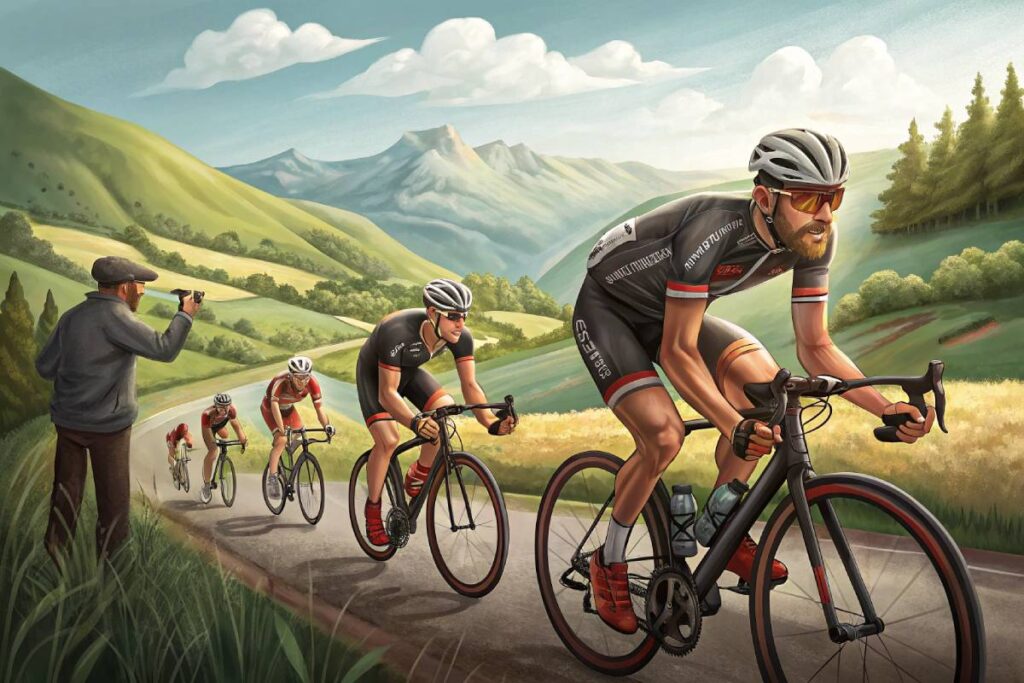
Elite Training Plan Structure
For the big league cyclists out there, the training blueprint is all about upping the ante with workouts that push your limits, fancy techniques, and making sure to catch some serious Z’s when it’s time to rest. Sneak a peek at a typical week:
| Day | Training Focus | Time (Hours) | Details |
|---|---|---|---|
| Monday | Chill & Recuperate | – | Lay back with some stretches, get a massage, maybe some yoga zen |
| Tuesday | Speed Bravado | 2-3 | Blitz through sprints, chill out between those bursts |
| Wednesday | Stamina Builder | 4-5 | A long, steady ride to pack on the endurance |
| Thursday | Uphill Battle | 2-3 | Hill repeats to make those climbs less of a grind |
| Friday | Easy Glide | 1-2 | Keep it mellow, work on your biking finesse |
| Saturday | Distance Marathon | 5-6 | Mix some speed and endurance while you’re clocking those miles |
| Sunday | Team Play | 3-4 | Master drafting, pacing, and playing nice with your squad |
Don’t forget, top cyclists keep those core muscles rock solid and stay bendy to dodge injuries. Curious? Hop over to our road cycling training plan for the deets.
Training for Amateurs
Now, for the weekend warriors and hobby bikers looking to up their game, a good plan isn’t just nice—it’s needed. Baby steps first, then get faster, and longer, and make sure you’ve got time to chill:
| Day | Training Focus | Time (Hours) | Details |
|---|---|---|---|
| Monday | Rest & Unwind | – | Take it easy, maybe go for a walk or stretch it out a little |
| Tuesday | Quick Bursts | 1-1.5 | Short spurts with chill breaks in the mix |
| Wednesday | Steady Pedal | 1.5-2 | Keep a brisk pace on even ground |
| Thursday | Up You Go | 1-1.5 | Work those leg muscles on various slopes |
| Friday | Casual Roll | 1 | Go light, nothing too intense |
| Saturday | Long Haul | 3-4 | Pile on the miles, focus on building endurance |
| Sunday | Tricks of the Trade | 1-2 | Get fancy with road bike handling and other moves |
Amateurs should think about mixing in other sports and keep those muscles stretchy. Need more tips? Jump into our road cycling training plan for amateurs for some solid advice.
No matter if you’re rolling with the pros or pedaling for fun, know your road bike geometry and why something like road cycling cadence isn’t just a weird term. Make sure that the ride fits you right (road bike sizing), have the right gear like the best road cycling shoes, and fuel up with the right grub (road cycling nutrition). Keep your bike from falling apart with regular road bike maintenance trust us, you don’t want squeaky brakes stealing your thunder.
Road Cycling Racing Tactics
Gettin’ the hang of road cycling race strategy is your golden ticket to shining on the circuit. Dive into these slick moves used when the rubber meets the road, and give a nod to the top UCI squads known for their abilities to outsmart the pack.
Key Strategies in Races
Winning in road cycling is all about knowing when to play your cards. These nifty tricks like drafting, breakaways, climbing, handling crosswinds, and the cunning gruppetto stratagem are just a few. Let’s break it down:
- Drafting: Tagging behind a fellow rider means you’re basically cheating the wind. It keeps the energy bank full for when the sparks start flying (cycling drafting technique).
- Breakaways: Make a slick move to ditch the peloton and grab a nice little lead. This usually means having the guts and timing of a daredevil, often working with teammates who’ve got your back.
- Climbing: Standout climbers balance brute force with smart energy-saving to dominate those uphill killers (road bike climbing techniques).
- Crosswinds: These cheeky breezes can whip up chaos, forming echelons that make others huff and puff just trying to stick in the slipstream.
- Speed Management: It’s all about guarding your gas tank till it’s time to floor it in those last kilometers.
- Gruppetto: A band-aid for sprinters and less mountain-happy riders—stick together to tackle climbs and beat the clock out of the danger zone.
These aren’t just moves; they’re a whole playbook for anyone looking to up their game. If you crave more insider scoop, our guide on road cycling techniques awaits.
UCI Professional Teams
Here’s where world-class teamwork and planning make champs out of teams. Check out who’s crushing it in 2023:
| Team | Notable Achievements |
|---|---|
| Jumbo – Visma | Raking in Grand Tour titles and bagging stages left and right. |
| UAE Team Emirates | Bringing home the bacon from the Tour de France and a bunch of other big-league races. |
| Soudal – Quick Step | Masters of mad sprints and A+ teamwork with a soft spot for one-day combats. |
| Ineos Grenadiers | Elite in stage gauntlets with Grand Tour wins aplenty under their belt. |
| Bahrain Victorious | Stalwarts keep defying the odds with praiseworthy race standings. |
| Lidl – Trek | Stalwarts that keep defying the odds with praiseworthy race standings. |
| Bora – Hansgrohe | Sure-footed sprinters who make their mark on different surfaces. |
| Groupama – FDJ | Team spirit and individual triumphs make them ones to watch. |
| Alpecin – Deceuninck | Sprints on lock plus full-throttle team maneuvers. |
| EF Education – Easypost | Known for crafty race tactics and tons of global conquests. |
These pros stand on the winners’ podium thanks to nose-to-the-grindstone teamwork, just like Mark Cavendish often does, not forgetting his trusty teammates.
The thrill of road cycling comes from cracking these strategies until they’re second nature. If you’re looking at joining the peloton, peep our picks for best cheap road bikes or slap on comfy best road bike saddles. Ride smart, ride happy!
Factors Influencing Performance
Grasping what influences cycling performance isn’t just for the pro riders; it’s for anyone wanting to pedal harder and smarter. Let’s look at the physical and mental sides that make or break a cyclist’s game.
Physiological Aspects of Performance
Now, what’s cooking under the helmet? A cyclist’s body is a marvel of nature and science. Here are the MVPs:
- VO2 Max: That’s the geeky way of saying how much oxygen your muscles can soak up when you’re going full throttle. Think of it as your endurance engine. More VO2 max = more time you can ride like the wind.
- Lactate Threshold: This is when your muscles start screaming for mercy. Training to push this threshold means you can keep the hammer down longer before your legs turn to jelly.
- Muscle Make-Up: Different strokes for different folks. Sprint champs usually sport more fast-twitch muscle fibers for those jaw-dropping bursts of speed, while endurance riders rely on slow-twitch fibers to keep going and going.
- Body Composition: Tune-up your body like you would a bike. Lighter frames don’t just make climbing easier; packing muscle can beef up your sprint.
- Power-to-Weight Ratio: Here’s where the math comes in handy—more power with less weight means climbing like a mountain goat.
| Physiological Factor | Why It Matters |
|---|---|
| Aerobic Capacity (VO2 Max) | Keeps you going longer |
| Lactate Threshold | Sustain tough efforts |
| Muscle Composition | Dictates speed and endurance |
| Body Composition | Fine-tunes performance |
| Power-to-Weight Ratio | Key for climbing victories |
For those who can’t get enough of the nitty-gritty, our training plans could be your next stop!
Psychological Factors in Cycling
But hey, don’t forget. The body might be the engine, but the mind is the driver! Here’s how you keep your head in the right lane:
- Motivation: Keeping your passion burning is tough when the going gets rough. Whether it’s goals or a killer training plan, stay jazzed!
- Mood and Anxiety: Nerves can wreck your focus. Find your inner zen and tell pre-race jitters who’s boss.
- Self-Belief: Believing in yourself can be just as powerful as muscle. Confidence = clutch performance when it counts.
- Pain Management: Pain’s all in the game. Champs know tricks to push past the hurt and stay in the race.
- Focus: Keeping your eyes on the prize keeps you from making rookie mistakes that’ll cost more than just time: they keep you upright, too!
- Brain Power: Knowing when to push, and when to save energy—those smarts can win races more often than raw power.
| Psychological Factor | Performance Boost |
|---|---|
| Motivation | Fuels your journey |
| Mood and Anxiety | Keeps stress at bay |
| Self-Confidence | Powers through pressure |
| Pain Management | Guts it out |
| Focus and Concentration | Promotes safety and smart moves |
| Cognitive Skills | Makes or breaks race plans |
Want more next-level secrets? Our cycling techniques can help you unlock the keys to mental mastery.
Blending these body-mind hacks can help pedaling fanatics harness the sweet synergy of their strategies and bikes (whether decked out or DIY). So, get set to rock every ride!
Olympic Road Cycling Events
Hey, curious about the adrenaline-pumping world of Olympic road cycling? Let’s break down the nitty-gritty of the games, from rules to wild routes that’ll rev up any cycling fan.
Rules and Competition Format
Saddle up for two main types of races: individual time trials and road races.
Individual Time Trials:
- Limited seating here – two athletes per country, max.
- 35 cyclists each for the men’s and women’s events at the Paris Olympics.
- Riders take off every 90 seconds—like clockwork.
- Keep your wheels to yourself! No trailing behind others, and respect the 2-meter “bubble” if someone overtakes.
Road Races:
- Each gender showcases 90 enthusiastic riders.
- Up to four cyclists from each country get a shot.
- Everyone jumps in together, rolling through bustling city streets and scenic backroads.
These formats keep it fair, exciting, and full of surprises for fans everywhere. For deeper insight into road cycling techniques, swing by our guide.
Courses and Distances
Now, let’s check out the playing field, where endurance meets speed and wits.
Individual Time Trials:
- The Paris setup stretches over 32.4 kilometers (a shade over 20 miles).
- Mostly flat terrain, setting the stage for blistering speeds.
- Riders will zip through in 35 to 40 minutes.
- The whole show wraps up in about 90 minutes.
Road Races:
- Men tackle 273 kilometers (a hefty 169 miles).
- Women’s course isn’t light either, at 158 kilometers (98 miles).
- Both tracks kick off and wrap up at the iconic Trocadero in Paris.
- Riders even face the infamous cobbled climbs at Butte Montmartre towards the end.
These grueling paths call for more than just muscle—strategic finesse is key. Athletes juggle stamina, positioning, and race dynamics to clinch the win. To boost your know-how on road cycling race strategy, don’t miss our in-depth take.
| Event | Distance (km) | What’s the Deal? |
|---|---|---|
| Men’s Time Trial | 32.4 | Speed lovers, rejoice—it’s flat! |
| Women’s Time Trial | 32.4 | Flat and fast, just like the men’s |
| Men’s Road Race | 273 | Paved with cobbles, starting and ending at Trocadero |
| Women’s Road Race | 158 | Ditto on the cobbles, Trocadero fun too |
Grasping these rules and course features is gold for newbies, fitness buffs, or competitive folks aiming to make waves in road cycling. For practical nuggets, dig into our pieces on road bike maintenance and cycling recovery tips.
Conclusion
Mastering road cycling race strategies is akin to orchestrating a symphony where every element harmonizes to create a masterpiece of performance and victory.
From understanding the intricate factors that influence speed and adapting to ever-changing environmental conditions to leveraging the power of teamwork and strategic collaboration, each aspect plays a pivotal role in shaping the outcome of a race.
Whether you’re navigating the challenging terrains of a cyclocross course or fine-tuning your training regimen to boost physiological and psychological resilience, the journey to excellence is multifaceted and rewarding.
Embracing these strategies not only enhances your competitive edge but also enriches your overall cycling experience. By learning from the pros, implementing effective race tactics, and continuously refining your skills, you pave the way for consistent improvements and memorable triumphs on the road.
Remember, cycling is as much a mental game as it is physical, requiring determination, focus, and adaptability. As you apply these insights and commit to your training, you’ll find yourself not just participating in races, but truly mastering the road to victory. So gear up, stay strategic, and let every ride bring you closer to your cycling aspirations.
FAQs
What are the key factors that affect cycling speed during a race?
Wind conditions, elevation changes, and the cyclist’s physiological state influence speed.
How do team dynamics influence race outcomes in road cycling?
Effective teamwork, clear roles, and strategic collaboration can significantly enhance a team’s chances of winning.
What training strategies are recommended for amateur cyclists preparing for races?
Amateurs should follow a balanced training plan that includes endurance rides, speed work, hill training, and adequate rest.
How can cyclists adapt to different environmental conditions during a race?
Cyclists can acclimatize to heat, manage hydration, adjust their riding position, and choose appropriate gear to handle varying conditions.
What are the essential race tactics every road cyclist should master?
Drafting, breakaways, speed management, and strategic climbing are crucial tactics for competitive road cycling.
Final Thoughts
Embarking on the journey to master road cycling race strategies is both exhilarating and challenging. It requires a blend of physical prowess, strategic thinking, and seamless teamwork.
Cyclists can significantly enhance their performance and race outcomes by delving into the intricacies of speed factors, understanding the pivotal role of team dynamics, and adapting to diverse environmental conditions.
Moreover, tailored training regimens and effective race tactics are indispensable tools that empower both amateur enthusiasts and seasoned professionals to push their limits and achieve their goals.
At MyBikeReview.com, we’re committed to providing you with the insights and resources needed to excel in every ride. Whether you’re aiming to conquer local races or eyeing podium finishes in grand tours, the strategies discussed here lay a solid foundation for your cycling endeavors.
Remember, success in road cycling is not just about the strength of your legs, but also the sharpness of your mind and the synergy of your team. So, gear up, stay informed, and let every pedal stroke bring you closer to victory. Here’s to countless miles, unforgettable races, and the relentless pursuit of cycling excellence!
Key Tips Around Road Cycling Race Strategies
- Optimize Your Drafting: Ride closely behind teammates to reduce wind resistance and conserve energy for critical moments.
- Understand Your Role: Know whether you’re a leader, domestique, sprinter, or climber, and perform your role effectively within the team.
- Adapt to Weather: Adjust your strategy based on wind conditions, temperature, and terrain to maintain peak performance.
- Plan Your Breakaways: Time your moves to escape the peloton when you have the best chance to sustain your lead.
- Maintain Communication: Use clear and consistent communication with your team to coordinate tactics and respond to race developments.
- Focus on Nutrition and Hydration: Proper fueling ensures you have the energy needed for intense bursts and long climbs.
- Train Specifically: Tailor your training to improve areas like endurance, speed, climbing ability, and sprinting power.
- Stay Mentally Strong: Develop resilience and focus to overcome challenges and maintain your race strategy under pressure.
- Analyze the Course: Study the race route in advance to identify key sections for strategic moves and energy management.
- Regular Bike Maintenance: Keep your bike in optimal condition to prevent mechanical issues that could derail your race.
Recommended Biking Products and Accessories
- Road Bikes:
- Trek Domane SL 7: Known for its endurance-focused design and smooth ride.
- Specialized Roubaix: Features advanced vibration-damping technology for long races.
- Cycling Apparel:
- Pearl Izumi Pro Racing Kit: Lightweight and breathable, perfect for competitive races.
- Castelli Aeronautica Pro Bibshorts: Offers excellent compression and comfort.
- Cycling Shoes:
- Sidi Wire 2 Carbon: Durable with excellent power transfer.
- Shimano SH-RP5: Comfortable and efficient for long rides.
- Accessories:
- Garmin Edge 1030: Comprehensive GPS cycling computer with advanced tracking.
- Specialized Power Meter: For accurate power output measurement.
- Nutrition:
- GU Energy Gel: Quick energy boost during intense rides.
- Hammer Nutrition Endurolytes: Essential electrolytes to maintain hydration.
- Bike Maintenance:
- Park Tool CO2 Inflator: Quick tire inflation on the go.
- Pedro’s Tire Levers: Durable and easy-to-use for quick tire changes.
- Safety Gear:
- POC Tectal Race SP Helmet: Lightweight with excellent protection.
- Light & Motion Urban 500 Bike Light: High-visibility lighting for safety during races.
- Training Tools:
- Wahoo Kickr Smart Trainer: For effective indoor training sessions.
- Zwift Subscription: Interactive training platform to enhance your performance.
- Hydration:
- CamelBak Podium Chill: Insulated water bottle to keep drinks cool.
- Polar Bottle Insulated Water Bottle: Durable and leak-proof for long rides.
- Tech Gadgets:
- Suunto 9 Baro GPS Watch: Robust watch with extensive tracking features.
- Bontrager Core Vuelta Bike Computer: Simple interface with essential metrics.

